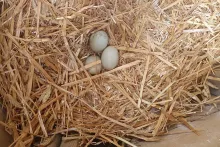
Red-crested pochard (Netta rufina)
Species name
- Dutch name:
- Krooneend
- English name:
- Red-crested pochard
- German name:
- Kolbenente
- French name:
- Nette rousse
- Scientific name:
- Netta rufina
Scientific classification
- Order:
- Anseriformes
- Family:
- Anatidae
- Onderfamilie:
- Aythyinae
- Genus:
- Netta
Description
- Description:
Male:
Has a rounded orange head, red bill and black breast. The flanks are white, the back brown, and the tail black. Eclipse males are like females but with red bills.Female:
Is mainly a pale brown, with a darker back and crown and a whitish face.Juvenile:
Looks similar to the females but have multicolor bellies and Young males look like eclipse adult drakes.
Standard Measurements
- Body Length (cm):
- The male (drake) of the Red-crested pochard measures approximately 48-64 centimeters. The female measures approximately 48-64 centimeters.
- Body Weight (grams):
- The male will weight about 995-1360 gram. The female will weight about 995-1360 gram.
The weight is notoriously variable and can only be used as indication!
- Note:
The nest is never far from water, occasionally on matted reeds in water. The nest is a small depression lined with grass, leaves, rushes, and down. Cup formed by turning movements of body.
- Breeding:
- The female Red-crested pochard usually lays from 8-12 pale green eggs and incubates them for 26-28 days.
- Artificial incubating:
The ideal relative humidity for incubating most waterfowl eggs is 55% (ground nesters) and 40% (cavity nesters). The temperature is usually 37.4°C. Set ventilation as recommended by the incubator manufacturer. Eggs must be turned, either automatically or by hand, a minimum of 4 times a day. As the duckling develops there is a loss of water from the egg and the air sac gets bigger. In normal development of an egg with a 26-28 days incubation, the air sac occupies about a third of it three days earlier. Cleanliness is vital and ideally eggs should be moved to a separate hatcher at this point, where the humidity should be increased to 65% and even higher once they have pipped internally.
- Bird banding:
- Recommended closed leg band ring size for the Red-crested pochard is 11 mm.The leg band ring can only be applied on a young duck at around 12-14 days old.
- It doesn't matter what leg that you band, but it's good to have a consistent system. Suggested: Left leg = Female, Right leg = Male
- Rearingfeed:
-
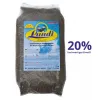
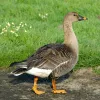

Floatable special rearing feed for all types of aquatic ornamental fowl - especially for the cultivation of trees as well as greening ducks.
This well-balanced complete feed with 20% protein content convinces above all by its good compatibility and forms the basis for visibly healthy growth from day one.
Made exclusively from wholesome and selected raw materials, Lundi Micro Regular is also ideally suited for the year-round feeding of waterfowl.
- Maintenance food:
-



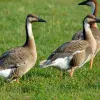

Lundi Regular with a protein content of 20%, valuable Spirulina and high-quality by-products is optimally balanced in its composition maintenance food for water ornamental fowl of all kinds. Especially green teal and Whistling ducks that are not dependent on a very high protein content, are well supplied.
Lundi Regular contains all the minerals and vitamins in full form that are important for the animals. Therefore also suitable as breeding food.


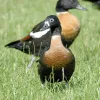


Floating full food for all sea ducks, green ducks, eider ducks and geese, especially in the moulting and breeding phase ideally suited. Packed with wholesome raw materials, natural vitamins and trace elements, this performance food with a protein content of 30% forms the basis for lifelong vitality.
- Regulation:
- Europese soort
- Regulation:
Het is niet verboden om deze vogels te houden die van nature in Nederland voorkomen, op voorwaarde dat deze vogels in gevangenschap zijn geboren; nakweek dus. Deze vogels zijn voorzien van een gesloten pootring. Het is wel verboden om deze vogels te houden die in het wild gevangen zijn. Alleen bepaalde instanties, zoals vogelasiels en vogelhospitalen, zijn bevoegd om jonge en gewonde wilde vogels te houden. Deze bescherming van vogels wordt vormgegeven door schadelijke handelingen te verbieden zoals:het doden, verwonden, vangen, bemachtigen en met het oog daarop opsporen van vogels (art. 9 Flora- en faunawet); het opzettelijk verontrusten van vogels (art. 10 Flora- en faunawet);het beschadigen, vernielen, uithalen, wegnemen en verstoren van nesten, holen of andere voortplantings- of vaste rust- of verblijfplaatsen van vogels (art. 11 Flora- en faunawet);en het zoeken, rapen, uit het nest nemen, beschadigen of vernielen van eieren van vogels (art. 12 Flora- en faunawet).


